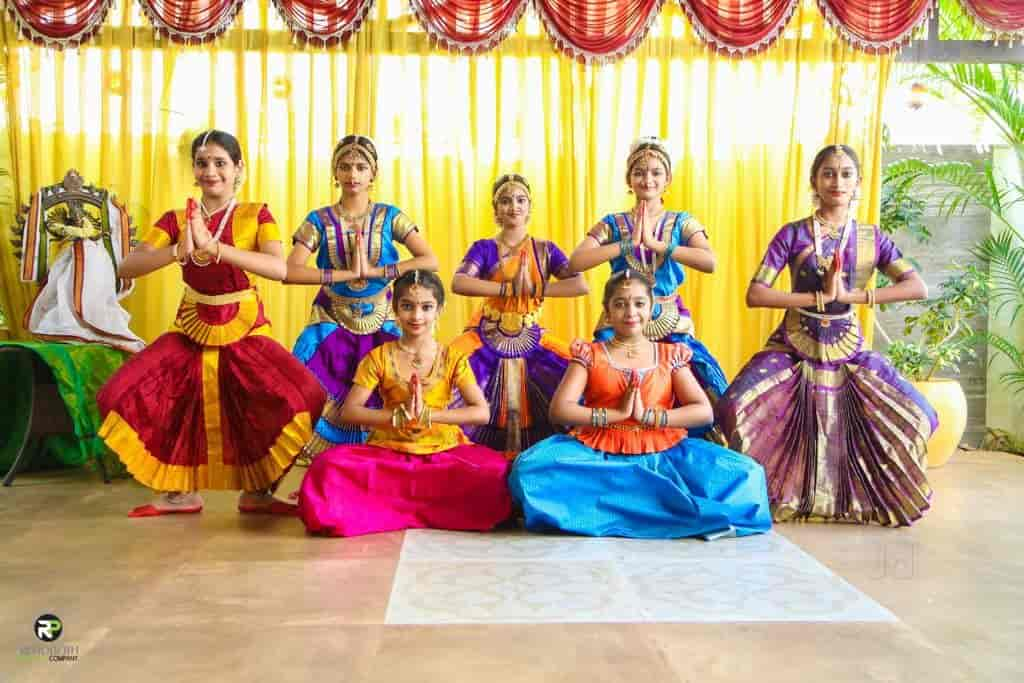
Dance in Chennai
Chennai is also known for the classical Indian dance, the Bharatanatyam, which is also the official dance of Tamil Nadu. An important cultural centre for Bharatanatyam is Kalakshetra (Sanskrit for "place of the arts"), located on the beach in the south of the city.
Kalakshetra, as the name suggests, is a centre for artistic endeavour. Founded in 1936 by the vibrant visionary Rukmini Devi Arundale, the Institution stands testimony to her dream of creating a space where the essence of Indian thought would find expression through artistic education. An institution she established with the vision “of imparting to the young the true spirit of Art, devoid of vulgarity and commercialism.” Spread over almost 100 acres by the seashore in Chennai, the Kalakshetra Foundation, as it is known today, is a vital centre for the study and performance of fine arts.
Popular Folk Dance
Mayil Attam – Women dancers adorned with peacock feathers, glittering headdress, and a beak perform this dance to the tune..
Kummi – This classical dance form has women standing in a circle, clapping their hands to add beats. It is performed at…
Kai Silambu Attam – Performed in temples during Navratri or Amman festivals, the dancers hold anklets or silambu to give…
Bharatnatyam – A dance performed only by women, Bharatnatyam depicts religious themes and spiritual ideas of South India.
Karakattam – Rain goddess Mariamman is praised through this ancient folk dance of Tamil Nadu. The Aatta Karakam form of this dance has decorated pots on the .dancers heads and Sakthi Karakam is performed as a religious offering.
Bhagavatha Nandanam – The life and glory of Lord Vishnu in his various avatars is depicted through this dance drama. It is performed at Narasimha Jayanthi and also during Gokulastami or Ramnavami.
Oyilattam – Dancers perform this dance to narrate the mythological stories of Murugan and Valli or Lord during temple festivals. The only musical instrument involved is a set of bells worn around the anklets of dancers.
Kavadi Attam – Performed only by men, this dance involves balancing a Purasai or Teak wood pole with pots of milk or coconut water fixed on either end. It is a religious dance worshipping Lord Murugan.
Karagam – The villagers perform this dance to honor the rain goddess Mariamman and the river goddess Gangaiamman. The folk music used in this dance is given by drums and long pipes.
KOLAATTAM – This dance is performed by women holding two sticks, which are beaten to make a rhythmic sound. Pinnal Kolattam involves making lace patterns using ropes. It is performed during Deepavali cultural holidays for ten days.
KURAVANJI – A blend of folk and classical dance, Kuravanji used to be performed by Devadasis in temples. With Devadasis being denied entry in temples, this dance comprising of love ballads is receding to shadows.
PAVAI KOOTHU – Deerskin puppets perform this dance while an idakka drummer and a singer provide regional folk melodies. This dance spread over 21 days, stages all the episodes of the Kamba Ramayana in Tamil.
BOMMALATTAM – Characterised by puppet shows, Bommalattam has puppets made of cloth, wood, and leather etc. Stories from Puranas, epics, and folklore are enacted in an entertaining mode for kids as well as adults.
Kummi – This classical dance form has women standing in a circle, clapping their hands to add beats. It is performed at…
Kai Silambu Attam – Performed in temples during Navratri or Amman festivals, the dancers hold anklets or silambu to give…
Bharatnatyam – A dance performed only by women, Bharatnatyam depicts religious themes and spiritual ideas of South India.
Karakattam – Rain goddess Mariamman is praised through this ancient folk dance of Tamil Nadu. The Aatta Karakam form of this dance has decorated pots on the .dancers heads and Sakthi Karakam is performed as a religious offering.
Bhagavatha Nandanam – The life and glory of Lord Vishnu in his various avatars is depicted through this dance drama. It is performed at Narasimha Jayanthi and also during Gokulastami or Ramnavami.
Oyilattam – Dancers perform this dance to narrate the mythological stories of Murugan and Valli or Lord during temple festivals. The only musical instrument involved is a set of bells worn around the anklets of dancers.
Kavadi Attam – Performed only by men, this dance involves balancing a Purasai or Teak wood pole with pots of milk or coconut water fixed on either end. It is a religious dance worshipping Lord Murugan.
Karagam – The villagers perform this dance to honor the rain goddess Mariamman and the river goddess Gangaiamman. The folk music used in this dance is given by drums and long pipes.
KOLAATTAM – This dance is performed by women holding two sticks, which are beaten to make a rhythmic sound. Pinnal Kolattam involves making lace patterns using ropes. It is performed during Deepavali cultural holidays for ten days.
KURAVANJI – A blend of folk and classical dance, Kuravanji used to be performed by Devadasis in temples. With Devadasis being denied entry in temples, this dance comprising of love ballads is receding to shadows.
PAVAI KOOTHU – Deerskin puppets perform this dance while an idakka drummer and a singer provide regional folk melodies. This dance spread over 21 days, stages all the episodes of the Kamba Ramayana in Tamil.
BOMMALATTAM – Characterised by puppet shows, Bommalattam has puppets made of cloth, wood, and leather etc. Stories from Puranas, epics, and folklore are enacted in an entertaining mode for kids as well as adults.
